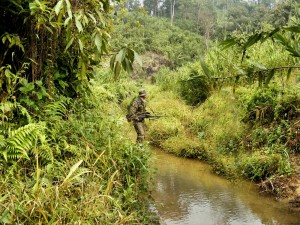Hand and Arm signals are one of the most common forms of communication used by United States Army soldiers or group of soldiers when a radio silence is in effect or if the soldiers need to remain undetected. Hand and Arm signals also become useful in situations of overwhelming sound such as a vehicle motor pull with equipment running, from one vehicle to the other via turret gunners while on a convoy, or during the noise of combat.
Through the use of these signals military leaders, such as team leaders, squad leaders, platoon leaders, etc…, are able to keep command and control over their particular element. All new recruits are taught to utilize the proper hand and arm signals found in the FM. However, it is not uncommon for units to adopt and/or create their own signals. These signals ultimately become known as SOP or standard operating procedure.
Visual signals are any means of communication that require sight and can be used to transmit prearranged messages rapidly over short distances. This includes the devices and means used for recognition and identification of friendly forces.
Like all other types of signals, visual signals do have their downfalls and limitations. The first limitation one can see is the range and reliability. Within this limitation, visual communication can become greatly disrupted during periods of poor visibility or when the terrain restricts clear observation. The second limitation one can see is misunderstanding. Many units do not follow specific Army doctrine (FM), but rather adopt their own SOP’s. With thousands of different units, it is highly likely that unit SOP’s will begin to overlap and cross each other. The third limitation one can see is how vulnerable visual signals are to enemy interception; thus allowing the enemy to use our own signals for deception purposes.
Attached is the army FM 21-60; please download and use as a reference for when you devise your own guerilla SOPs.
Jon
For quick information I referenced wikipedia; if you were curious.


Leave a Reply